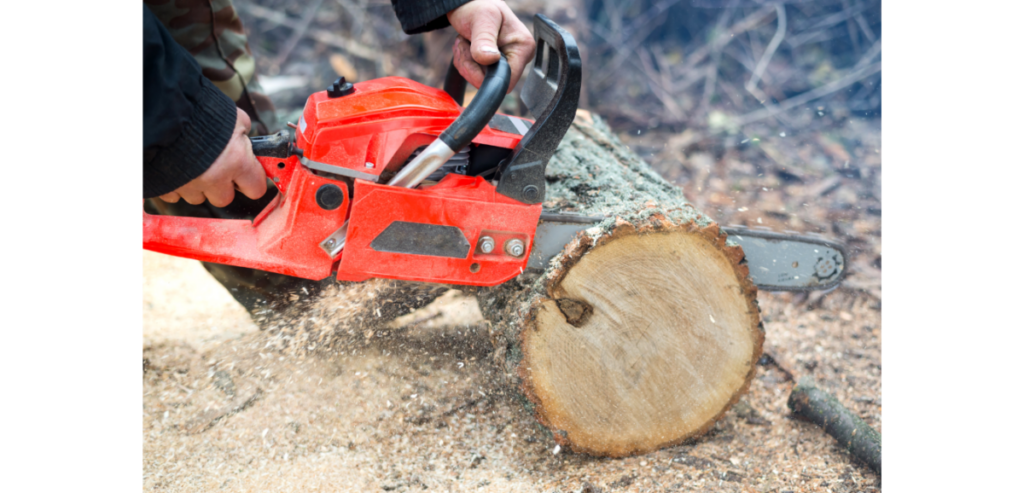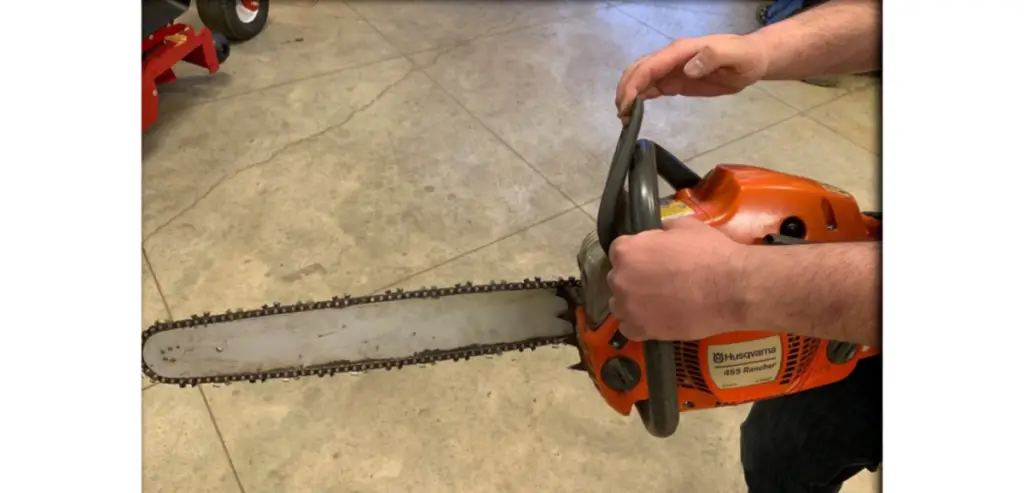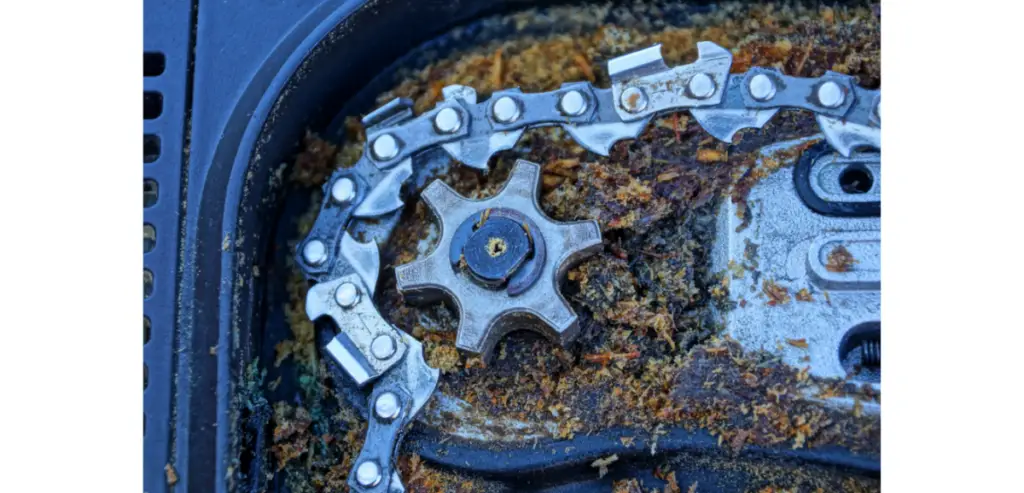
Chainsaws make our outdoor chores easier. Tasks like trimming low-hanging tree branches, felling small or larger trees, or simply cutting up some firewood much quicker and less laborious. If we didn’t have chainsaws or outdoor lives would be noticeably different and much harder. However, chainsaws are only helpful when in a proper operating condition. Sometimes a chainsaw will start properly and appear to be operating correctly and when you’re about to make the first cut you notice that your chain does not move when the throttle is engaged. Numerous things may cause the chain not to turn.
A chainsaw chain not turning can be caused by the chain brake being engaged, worn guide bar, damaged chain, non-functioning chain oiler, or worn out clutch.
The situation of a stuck chain can be incredibly frustrating for anybody. However, this is usually a very easy problem to correct with little knowledge, even for the novice chainsaw user. Below I will discuss each of these situations and how to fix them.
Chain Brake Engaged

You may be asking yourself what is a chain brake on a chainsaw. The chain brake is simply a safety measure installed on chainsaws to keep the operator safe. Chainsaws can be deadly if appropriate care is not taken. Chain brakes should be purposely used by the chainsaw operator when starting the chainsaw, walking to a new work area, or when in close proximity to other people. There are other situations where an operator would need to use a chain brake but these are when the chain brake is typically used.
If an operator has not been properly instructed on the chainsaw’s chain brake and how to engage and disengage the break it can be dangerous and frustrating. Not knowing that a chain brake exists and how to disengage it can make an operator think the saw is broken when in reality the brake just needs to be in the released state.
The chain brake will be located directly in front of the main chainsaw handle. In order to engage the chain brake the handle is simply pushed forward. To disengage the chain brake the handle needs to be pulled back.
Worn Guide Bar

The guide bar is the long bar that is holding the chain on the chainsaw. There are 3 primary ways a guide bar can prevent a chain from turning properly.
The first way would be a worn guide bar sprocket. The purpose of the guide bar sprocket is to help the chain to spin around the tip of the bar with as little friction as possible. If this sprocket cant turn then the chain won’t be able to turn as well. You can check this by removing the bar and chain from the saw. Once the bar and chain are removed from the saw then remove the chain off the guide bar. You should be able to now see the sprocket on the tip of the bar. If the sprocket will not turn then you know it’s locked up and time to replace the guide bar. If the sprocket is able to rotate and the chain is still not able to turn then the bar may be split at the sprocket. If this is the case the chain is more than likely getting wedged between the edge of the bar sprocket and the side of the bar and replacement will be necessary.
The second way a guide bar can prevent a chain from spinning is a pinch in the guide bar slot rail. If the slot rail has been pinched between some wood the chain will not have room to slide thru the rail slot. You can check this by removing the guide bar from the saw. Usually, the pinch will be easily spotted. If the bar is pinched it’s better to replace the bar than try to loosen the pinched area.
The third and final way a guide bar can prevent a chain from turning is if the guide bar is bent. If this is the case it will be obvious and the guide bar will need to be replaced.
Damaged Chain

The chainsaw chain is what does the actual cutting when the saw is operating properly. However, the chain can be damaged to the point where the chainsaw is not able to be turned by the chainsaw. This type of damage can not be seen without removing the chain from the guide bar.
Once the chain is removed inspect the pointy-looking bottom part of the chain. This part of the chain is known as the chain drag. The chain drag slides in the guide bar slot rail. If this part of the chain is damaged the chain can not slide properly around the guide bar causing the chain to get stuck. The damage likely will not appear on every chain drag. More than likely the damage will be done to only a few of the chain drags. The damage is usually a burr (rough spot) and will be small but easily spotted. This damage is normally caused by running the chain without the proper amount of tension or from a worn sprocket. If the chain is damaged it will need to be replaced.
Non-Functioning Oiler

The function of an oiler on a chainsaw is to provide lubrication between the chainsaw chain and the guide bar. If the oiler is not functioning properly the chain and guide bar will overheat. Overheating can damage the guide bar and chain to the point of failure for either component and can cause the chain to not turn.
Oiler failure can be caused by the oil pump seizing from general wear and tear or getting plugged with debris. If the oil pump is seized you will more than likely need to take your saw to the dealer for repair.
There is also a chance that the actual oiler is functioning properly and the chain and guide bar are not receiving oil from the oiler. This is caused more than likely by a plugged oil port on either the chainsaw or guide bar. If either of these holes is plugged the oil will not be able to pass from the chain saw to the guide bar. If this is in fact the case the fix is to simply clean out the oil ports on the chainsaw and guide bar with compressed air. This will allow the oil to flow properly to the chain and guide bar solving your oiling problem
Worn Out Clutch

The clutch on a chainsaw is the component that transfers the power from the chainsaw’s engine to the sprocket which ultimately makes the chain turn to cut wood. Over time the clutch shoes can become worn and not able to transfer the saw’s power without slipping causing the chain to lose speed or stop completely. If your saws clutch is worn the replacement should probably be done by a servicing dealer. This repair is not that extensive and the dealer should be able to complete the repair in 30 minutes or less labor.
Wrapping Up
Chainsaws are a great tool when functioning properly. However, chainsaws do need occasional maintenance to keep them in top working order. If your chainsaw’s chain is not turning remember to check each of the items listed above and you should be able to either repair the problem yourself or tell your dealer what the problem is saving costly repair times.
Remember to always check your saws operator manual for the proper safety procedures for your particular chainsaw’s model. Be safe and take care.
